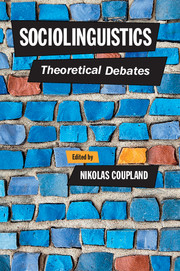Book contents
- Frontmatter
- Contents
- List of contributors
- Preface and acknowledgements
- 1 Introduction: Sociolinguistic theory and the practice of sociolinguistics
- Part I Theorising social meaning
- Part II Language, markets and materiality
- 6 Treating language as an economic resource: Discourse, data and debate
- 7 Theorising the market in sociolinguistics
- 8 Embodied sociolinguistics
- Part III Sociolinguistics, place and mobility
- Part IV Power, mediation and critical sociolinguistics
- Part V Sociolinguistics, contexts and impact
- Part VI The evolution of sociolinguistic theory
- Index
- References
8 - Embodied sociolinguistics
from Part II - Language, markets and materiality
Published online by Cambridge University Press: 05 June 2016
- Frontmatter
- Contents
- List of contributors
- Preface and acknowledgements
- 1 Introduction: Sociolinguistic theory and the practice of sociolinguistics
- Part I Theorising social meaning
- Part II Language, markets and materiality
- 6 Treating language as an economic resource: Discourse, data and debate
- 7 Theorising the market in sociolinguistics
- 8 Embodied sociolinguistics
- Part III Sociolinguistics, place and mobility
- Part IV Power, mediation and critical sociolinguistics
- Part V Sociolinguistics, contexts and impact
- Part VI The evolution of sociolinguistic theory
- Index
- References
Summary
Introduction: Habes corpus!
Bodies and embodiment are central to the production, perception, and social interpretation of language. In spoken languages, the body is the locus of the speaking voice and the listening ear, while in the case of sign languages the body supplies the grammar for the entire linguistic system (cf. Lucas and Bayley, this volume, Chapter 16), a fact that has important consequences for theorizing language in general as an embodied phenomenon. Embodiment is also enlisted in a variety of semiotic practices that endow linguistic communication with meaning, from the indexicalities of bodily adornment to gesture, gaze, and other forms of movement. And just as bodies produce language, so the converse also holds: Language produces bodies. That is, language is a primary means by which the body enters the sociocultural realm as a site of semiosis, through cultural discourses about bodies as well as linguistic practices of bodily regulation and management. Moreover, even as technologically mediated forms of communication may seem to displace physical bodies as sources of linguistic production, the body insistently reasserts itself in communicative practices in the spheres of technology and the media.
Despite the crucial role of embodiment in producing social meaning through language and vice versa, a broad-based discussion within sociocultural linguistics concerning the theoretical relationship between language and embodiment is largely lacking. Hence what we engage here is not a current debate but a needed interdisciplinary conversation that includes sociocultural linguists of all stripes (see Coupland and Gwyn 2003, inter alia, for one valuable starting point for this dialogue).
In part this lack of dialogue among research traditions can be attributed to methodological and analytic differences, which often prevent scholars investigating embodiment in one domain from drawing on work in other areas. But it is also due to a tendency in much sociolinguistic research to conceptualize the body as secondary to language rather than as the sine qua non of language. Perhaps this is unsurprising given that the discipline of linguistics as conventionally practiced is logocentric almost by definition. Within generative linguistics in particular, most embodied phenomena have been ignored or viewed as background noise or “performance” rather than as part of the abstract grammatical system of “competence” imagined to be the proper subject of linguistic scholarship.
- Type
- Chapter
- Information
- SociolinguisticsTheoretical Debates, pp. 173 - 198Publisher: Cambridge University PressPrint publication year: 2016
References
- 167
- Cited by



